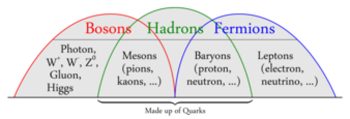By Vidya Rajan, Columnist, The Times
 In this article, I will extend the topic begun last month on the constitution of the universe as we currently understand it and simplify (or at least try!) the simply overwhelming vocabulary that attends this topic. And just to be clear about what the universe’s composition has to do with biology or bees…it has everything to do with biology and bees. Living organisms and what we live on and in is made of matter, and this is a way to understand ourselves and what is around us. It matters. (See what I did there?)
In this article, I will extend the topic begun last month on the constitution of the universe as we currently understand it and simplify (or at least try!) the simply overwhelming vocabulary that attends this topic. And just to be clear about what the universe’s composition has to do with biology or bees…it has everything to do with biology and bees. Living organisms and what we live on and in is made of matter, and this is a way to understand ourselves and what is around us. It matters. (See what I did there?)
To quickly summarize where I left off in the last article, the universe emerged in a blast of great energy, and that energy then coalesced within 1 second into either subatomic particles[1] or differentiated into forces encapsulated in what is termed the “Standard Model” of elementary particles (Figure 1). The subatomic particles produced coalesced into a billion times more “matter” particles than “antimatter” particles, giving our universe form and substance. Antimatter particles have the same breakdown as matter particles, but they have reversed charges. Matter and antimatter annihilate when they meet, but the rarity of antimatter makes such collisions rare. If you want to remind yourself of what the universe contains, please watch this video: https://youtu.be/5iGgA1ocBkE?si=5MnrXE3l7nrzSkM7.

Figure 1: The Standard Model. The particles in purple are quarks and include the up and down quarks which interact to make hadrons such as protons and neutrons located in an atom’s nucleus; the particles in green are leptons which includes the electron which orbit atomic nuclei. The force carriers that mediate interactions are shown in red. Forces are carried by particles called bosons, which includes the familiar photons of light. Reproduced from https://www.quantumdiaries.org/2014/03/14/the-standard-model-a-beautiful-but-flawed-theory/ under fair use.
The Standard Model represents in a nutshell what is known about the composition of the universe in terms of the basic particles, and the forces through which they interact.
But astrophysicists do not understand 95% of what makes up the universe. About 70% is something called “dark energy”, and about 25% is something called “dark matter”.[2] The remaining 5% is made of visible matter, which is made of atoms and makes up all the stars, planets, pulsars, quasars and dust clouds that pepper the universe and that we can observe either through the radiation (electromagnetic force mediated by photons) they produce (such as light or sound, using light or radio telescopes) or by their effects on matter (such as causing acceleration or deceleration of galaxies).
Dark stuff is just stuff that does not interact with the instruments that currently exist for sensing what is out there. But dark matter has mass and bends the fabric of space-time, distorting the usually straight path that light takes from point A to point B. So it’s there and can be mapped (similar to how we can map the presence of clouds on a dark night due to patches of sky where stars cannot be seen). Astrophysicists know where patches of dark matter exist and how big those patches are, but they don’t know what those patches are made of – it does not appear to be made of matter because it does not produce light emissions, such as how fireworks glow due to electrons jumping from one atom to another due to a chemical reaction, emitting photons. Dark energy is a complete mystery.
Its presence is inferred, again, by its indirect effects. In this case, astrophysicists think the reason that the galaxy is expanding (pushing galaxies further apart at a discernible rate) is due to the repelling effect of dark energy on matter. So dark energy is kind of an anti-gravity substance. A greater mystery is that its effect is increasing, because the galaxies are speeding apart faster and faster. It was thought that dark energy amounts were constant across time and permeated all of space (this is represented by a number that Albert Einstein dubbed “the cosmological constant”) but a 2024 study by the Dark Energy Spectroscopic Instrument showed that the amount of dark energy appears to have not been steady throughout time, and dark energy quantities may be getting lower or getting diluted as space expands.[3] This diminishment has not yet been confirmed by other research teams (which are looking). Any rationale will have to explain how decreasing amounts of repulsive dark matter can actually cause an increase the speed with which galaxies are moving apart. Much to discover there.
Back to matter. In the seething churn that was the early universe, matter popped out of energy fields and, reciprocally, matter spontaneously fizzles into forces. Contrary to our intuition, the reality in the universe is that things do appear from apparently nothing. Of course it is not really “from nothing” – there is energy everywhere in the universe[4] – and matter pops out due to the interconvertibility of matter and energy. If we had to start at the basics of the composition of the universe, we could start and end with forces. Everything is based in a matrix made of forces called the “field”, as in “quantum field theory”. In mathematical terms, the universe is a wave function, which is how fields are represented. That means that everything in the universe interacts (even dark matter by pulling with gravity and dark energy by pushing with anti-gravity). However, we can only perceive and measure particles, not waves. When physicists talk about particles being like a particle or like a wave, this is what they mean: When you don’t look at the thing (like light or an electron), it behaves like a wave; when you do, it behaves like a particle. If we measure it using tools of perception like telescopes, vision or microscopes, we perceive particles, because the wave function collapses and the thing being measured coalesces to a perceptible and describable unit.
The Standard Model shows only the fundamental components of the universe. These components combine and interact in various ways by four types of forces. Think of the universe as being a cobweb of different force fields with the interactions mediated by both particles and forces. Particles collapse into “being” when combined, and forces detract/reinforce each other’s waves without collapsing into “being”. These interactions become the next layer and are grouped into hadrons and fermions with constitute matter, and bosons which mediate forces: photons mediate electromagnetism,[5] W and Z bosons mediate weak interactions, and gluons mediate strong interactions within the nucleus. Electrons exchange photons (think of fireworks going off, which is really a chemical reaction in which electrons mediate bond rearrangements between atoms); gluons hold quarks together, and weak interactions allow particles to escape the nucleus of radioactive elements, such as radium.

Figure 2: Bosons, hadrons and fermions. A hadron is a composite subatomic particle, and must fall into one of the two classes: bosons (force carriers) and fermions (matter particles). Reproduced from https://en.wikipedia.org/wiki/Hadron under fair use.
The smallest indivisible part of matter with a distinct chemical identity is the atom. The nuclei of atoms contain protons and neutrons, with electrons that reside outside the nucleus mediate interactions with other atoms. The electron is a fundamental particle, but protons and neutrons are not. They are composites called hadrons made of quarks, specifically two types of quarks, called the up and down quarks. Protons contain two more up and one down quark, and neutrons have two more down and one up quark. These different quark combinations make up the “charge” that makes protons (+1 charge) different from neutrons (0 charge). Then they have a bucketful of other quarks together with their antiquark particles (e.g. strange-anti-strange quark pair; charm-anticharm quark pair etc.) The whole mess is held together by strong forces mediated by bosons (a type of force carrier) called gluons. (Think of gluons like yelling adults trying to corral a feisty and hyperactive group of kindergartners full of candy whose voices get louder as the kids run away. The gluon force gets stronger as quarks move apart.) Oh, and I should mention they can morph/disintegrate into other subatomic particles, as well as pop in and out of existence. But as long as there are always two more up and one more down quark in the shebang, the proton’s all good. And two more down and one more up quark for the neutron. Physics Girl explains it much better with candy here: https://youtu.be/LraNu_78sCw. Another thing: atoms are not mostly empty space at all. They contain orbitals which areas of probability in which electrons are found, so it is not a vacuum. An imperfect analogy is that a road is a road even if there are no cars on it at that instant.

Figure 3: Left: Classification of fermions. Right: Electron orbitals showing the space-filling structure of an atom in the 3rd period (such as silicon or chlorine). Leptons are massless, and hadrons have mass and are made of quark combinations. Mesons are force carrying particles in the category of bosons, and have equal (usually one) pair of quarks and anti-quarks, and baryons are made of three valence up and down quarks in two combinations (protons = 2 up+ 1 down quark; neutrons = 2 down and 1 up quark). Quarks in the atomic nucleus are held together by the strong force, mediated by the gluon. Reproduced from https://www.fizzics.org/baryon-number-and-conservation/ and https://www.nextbigfuture.com/2012/01/next-big-step-toward-atom-specific.html under fair use.
This flip from a matter state to a particle state is spontaneous and is the leverage behind particle accelerators like the Large Hadron Collider in Geneva, Switzerland. If hadrons are smashed with enough energy, they can produce (out of the energy) particles like mesons or the Higgs boson, even briefly. Conversely, energy can be released from gluons when unstable uranium-235 is hit by a neutron, causing it to break up (undergo fission) into two nuclei, krypton and barium. It also releases 3 neutrons which can go on to hit other uranium nuclei and destabilize to undergo fission also. If enough uranium-235 atoms are in the vicinity to be impacted by the neutrons, they each will break up and release 3 neutrons. Lots of energy is released as well. This is the principle behind the atomic bomb.

Figure 32: Fission products of uranium 235. Uranium has 235 neutrons and 92 protons. Note that the products contain the same total numbers of protons (92) and neutrons (235) as the reactants, so the energy of this immense explosion comes from strong forces that previously held the huge number of protons and neutrons together in the uranium nucleus.
The force is truly with matter.
Bibliography and Notes:
[1]. This is where Einstein’s equivalence of mass and energy equation, E=mC2 describes the energy contained in matter. E stands for energy, m for mass, and C for the speed of light in a vacuum (3×105 meters/second). According to this equivalence, a gram of water contains the energy equivalent of 20,000 tons of TNT. (https://science.howstuffworks.com/science-vs-myth/everyday-myths/einstein-formula.htm) This mass-energy equivalence was one of the four major discoveries Einstein published in his “annus mirabilis”, 1905. The other three major papers he published that year related to the photoelectric effect, Brownian motion and special relativity. Einstein received the 1921 Nobel Prize for his discovery of photoelectric effect.
[2]. Castelvecchi, D. (2024). Dark energy is tearing the Universe apart. What if the force is weakening? Nature, [online] 629(8011), pp.274–275. doi:https://doi.org/10.1038/d41586-024-01273-4.
[3]. It’s disconcerting to be told an instrument can look back in time because it is not our lived experience except through documentation, but this anomaly is explained more simply on universe-scale because these instruments measure light signals that were produced by galaxies and traveled through space at a known speed (light speed). Just as we can gauge the distance of an oncoming car by the quantity of light its headlights emit, so can these instruments tell how far they are. And just as a siren seems to change frequencies as a police car zooms fast, galaxies moving further away stretch light into the red region of the spectrum. The finding is that all galaxies are shifting into the red part of the spectrum and getting fainter. So the galaxies are moving apart. It’s more complicated that that, obviously, but this is the general principle.
[4]. Einstein called this energy factor the “cosmological constant”, represented by the Greek letter lambda (Λ).
[5]. Electricity and magnetism were described separately and were unified into a single force called electromagnetism by James Clerk Maxwell in “A Treatise on Electricity and Magnetism” in 1873.






